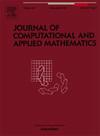时间分数型Fokker-Planck方程的连续Petrov-Galerkin方法
IF 2.1
2区 数学
Q1 MATHEMATICS, APPLIED
Journal of Computational and Applied Mathematics
Pub Date : 2025-04-11
DOI:10.1016/j.cam.2025.116689
引用次数: 0
摘要
提出了含分数阶指数α∈(0,1)的时间分数阶Fokker-Planck方程时间离散化的连续Petrov-Galerkin (CPG)方法。对于α∈(1/2,1),得到了时间离散解的α-鲁棒稳定性界。在误差分析方面,采用时间梯度网格来解决连续解在原点附近的奇异性。我们给出了非均匀时间网格下的节点误差估计,得到了α∈(1/2,1)的最优二阶精确估计。考虑了采用空间标准(连续)有限元法的全离散格式,并估计了相应的误差。数值实验表明,时间梯度网格的假设可以进一步放宽,结果对于α∈(0,1)具有二阶精度。本文章由计算机程序翻译,如有差异,请以英文原文为准。
A continuous Petrov–Galerkin method for time-fractional Fokker–Planck equation
A continuous Petrov–Galerkin (CPG) method for the time discretization of a time-fractional Fokker–Planck equation with a general driving force involving fractional exponent is proposed. An -robust stability bound for the time discrete solution is obtained for . Regarding error analysis, time-graded meshes are utilized to address the singular behavior of the continuous solution near origin. We present the nodal error estimate with non-uniform time meshes and obtain the optimal second-order accurate estimate for . The fully-discrete scheme by employing standard (continuous) finite element method in space is considered, and the corresponding error is estimated. Numerical experiments demonstrate that the assumptions of time-graded meshes can be further relaxed, and the results exhibit second-order accuracy for .
求助全文
通过发布文献求助,成功后即可免费获取论文全文。
去求助
来源期刊
CiteScore
5.40
自引率
4.20%
发文量
437
审稿时长
3.0 months
期刊介绍:
The Journal of Computational and Applied Mathematics publishes original papers of high scientific value in all areas of computational and applied mathematics. The main interest of the Journal is in papers that describe and analyze new computational techniques for solving scientific or engineering problems. Also the improved analysis, including the effectiveness and applicability, of existing methods and algorithms is of importance. The computational efficiency (e.g. the convergence, stability, accuracy, ...) should be proved and illustrated by nontrivial numerical examples. Papers describing only variants of existing methods, without adding significant new computational properties are not of interest.
The audience consists of: applied mathematicians, numerical analysts, computational scientists and engineers.

 求助内容:
求助内容: 应助结果提醒方式:
应助结果提醒方式:


